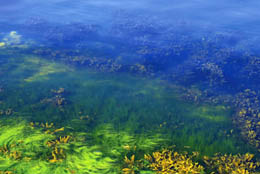
Seagrass is considered the canary in the coal mine for estuaries. When pollution leads to the darkening of a bay’s waters, sunlight-deprived seagrass is the first victim. Extensive seagrass meadows line the sandy bottom of the intricate bay systems throughout Sarasota. This precious resource is an environmental asset due to its ability to filter the water, ensuring clearer water for swimming and recreation. Teeming with life, seagrass also provides vital habitats for fish and shellfish species and attracts sport fish, which feed throughout the seagrass meadows.
The integrity of the seagrass meadows is currently threatened by years of land use changes, which have altered the natural landscape and changed the way water makes its way to bays in Sarasota. The city’s landscape was significantly altered in the early 1900s when extensive ditching and draining occurred to dry out land for agriculture. Originally, the natural landscape had pockets of isolated wetlands that would occasionally flow to the bays, but would mostly filter rainwater into the ground. In the 1950s, extensive urban growth flourished along the shore and gradually moved inland— encroaching further into the natural landscape. A proliferation of hardened surfaces from buildings and roadways covered the land, reduced natural landscape, and prohibited water from percolating into the ground. The result of these changes altered the timing and increased the freshwater and nutrients leaving the land and entering the bays.
The problem with increased freshwater and associated nutrients entering Sarasota’s water resources is that it creates an unlimited food source for algae, which in turn blocks sunlight and reduces water quality necessary for seagrass. Clean, clear water is essential to support healthy seagrass meadows. In recent years, Sarasota County has been working with regional agencies such as the Southwest Florida Water Management District to develop science-based water quality targets to support healthy seagrass and to specify the amount of nutrients entering water resources.
One approach to meet the targets and improve water quality is to reduce the amount of freshwater flow and nutrients by mimicking the hydrology of natural landscapes through Low Impact Design (LID ) techniques. These techniques simulate the way water historically filtered into the land by capturing and retaining water where it falls, thereby reducing the amount entering the bay and impacting seagrass. LID techniques consist of rain gardens, green roofs, cisterns, pervious systems, and storm water harvesting. These designs act like filters absorbing rain water, unlike hardened surfaces that cause rain water to quickly run off the land into bays.
There are multiple options to promote LID techniques to reduce nutrients entering Sarasota’s water resources. Local agencies could spend millions of taxpayer dollars on expensive LID retrofits of old infrastructure, or stringent regulations could require LID techniques in new and redevelopment, passing the cost on to the development community. Neither of these options would be positively perceived by the locals.
A better way to promote LID is to use a market-based approach. Through the creation of a program for property owners to retrofit their property using LID techniques, “credits” could be generated. For example, if residents install a green roof on their house, they could potentially get a certain amount of credit. Local agencies that permit development could inspect and certify the newly installed LID technique and act as a credit bank. When a developer comes in for a permit, he or she can perform a cost-benefit analysis to determine if it is more effective to install LID on their site or purchase credits to meet their needs without the use of LID techniques.
There is a minimal but effective government role for permitting and managing the credit bank. Only the future will tell if Sarasota is successful in implementing a market-based approach to protect an important environmental asset, seagrass. Protection of this resource will help to ensure a robust economy for future generations in Sarasota.



